Drinking Water Protection
- Drinking Water Protection Home
- About Us
- A-Z Index of Contaminants in Water
- Community Public Water Supply
- Drinking Water Grants and Loans
- Drinking Water Institute
- Drinking Water in Schools and Child Cares
- Drinking Water Revolving Fund
- Laws and Rules
- Noncommunity Public Water Supply
- Source Water Protection
- Water Operator and Certification Training
- Drinking Water Protection Contacts
Related Topics
- Annual Reports
- Drinking Water Risk Communication Toolkit
- Drinking Water Protection External Resources
- Fact Sheets
- Forms
- Invisible Heroes Videos: Minnesota's Drinking Water Providers
- Noncom Notes Newsletter
- Sample Collection Procedures (videos, pictures, written instructions)
- Waterline Newsletter
Related Sites
- 10 States Standards
- Clean Water Fund
- Health Risk Assessment – Guidance Values and Standards for Water
- Minnesota Well Index
- Water and Health
- Wells and Borings
Environmental Health Division
Waterline: Winter 2018 - 2019

Editor:
Stew Thornley
Subscribe to The Waterline newsletter. An e-mail notice is sent out each quarter when a new edition is posted to the web site.
On this page:
- Sandeep Burman Named MDH Drinking Water Protection Section Manager
- Lewis & Clark Regional Water System Nearly Complete in Minnesota
- Past Waterlines Archived at wateroperator.org
- Sign Up for Groundwater Updates
- Cool Videos
- Drinking Water Institute in Rochester
- Chaska Prevails in Great Minnesota Tap Water Taste Test
- Minnesota AWWA Conference
- Lewis & Clark: Nearing the Minnesota Finish Line
- Fact Sheets, Resources Now on MDH Web Page
- Historic St. Paul Ballpark Leads to Information on Early Water Supply in City
- New Display at State Fair Eco Experience
- MDH Funds Filling Stations
- Southeast School Changing Locations
- Words to Live By
- Reminder to All Water Operators
- Calendar
Sandeep Burman Named MDH Drinking Water Protection Section Manager
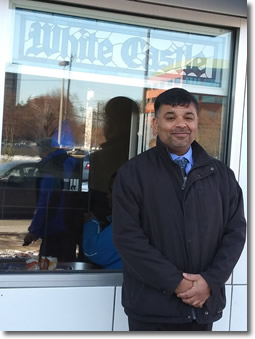 Sandeep Burman began as the manager of the Drinking Water Protection Section at the Minnesota Department of Health (MDH) November 14, succeeding Randy Ellingboe.
Sandeep Burman began as the manager of the Drinking Water Protection Section at the Minnesota Department of Health (MDH) November 14, succeeding Randy Ellingboe.
Sandeep has an educational background in hydrogeology and civil engineering. He did his undergraduate work in India and came to the University of Minnesota in 1991 for a masters degree, just in time for the Twins' World Series victory and the Halloween blizzard. An amateur mountain climber in India, he had to switch activities in the flatlands of Minnesota, and he now likes to hike, bike, and camp in Minnesota’s state parks, and also canoe in the Boundary Waters Canoe Area. As the picture shows, he is also willing to participate in other adventure sports, such as MDH "welcome" lunches at White Castle.
After graduate school, Sandeep began working at the Minnesota Pollution Control Agency (MPCA) as a hydrologist in the Rochester district office, alongside staff in the MDH drinking water program. He became a supervisor in the Petroleum Cleanup Program and moved to the St. Paul office. He then moved to the Superfund Program, dealing with the cleanup and redevelopment of polluted industrial sites. Throughout his MPCA career he has remained heavily involved with drinking water issues.
He most recently managed the MPCA's Site Remediation & Redevelopment Section and has strong working relationships across a broad spectrum of stakeholders, including regulated parties, communities, local/state government (including MDH), federal agencies, and national organizations.
Sandeep lives with his wife, Renee, and two teenaged daughters, Jayita and Nadia, in Rosemount.
Go to top
Lewis & Clark Regional Water System Nearly Complete in Minnesota
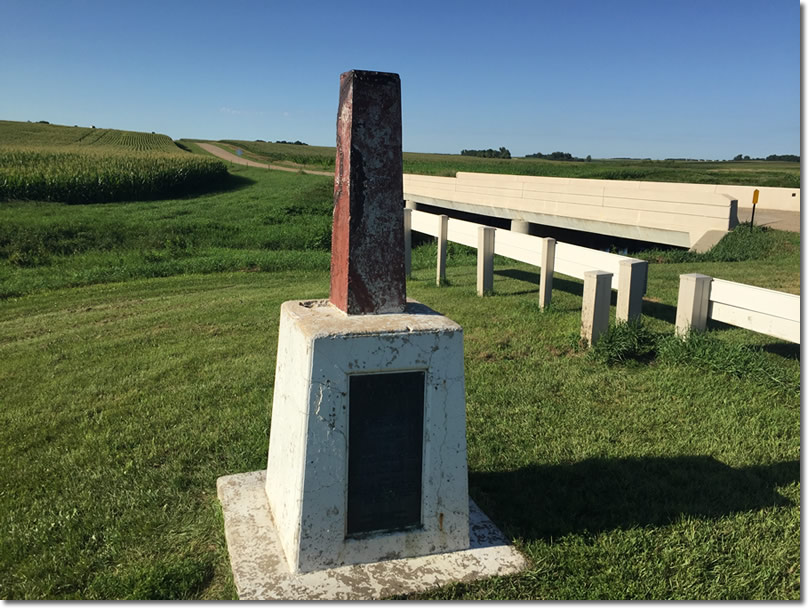
Off a dusty crossroads stands a marker designating the site where Minnesota, Iowa, and South Dakota meet. These three states have come together in another way, with the creation of the Lewis & Clark Regional Water System. A treatment plant near Vermillion, South Dakota, several miles north of the Missouri River, now processes more than 23 million gallons per day to distribute to the tri-state area. Its capacity may one day reach 60 million gallons per day.
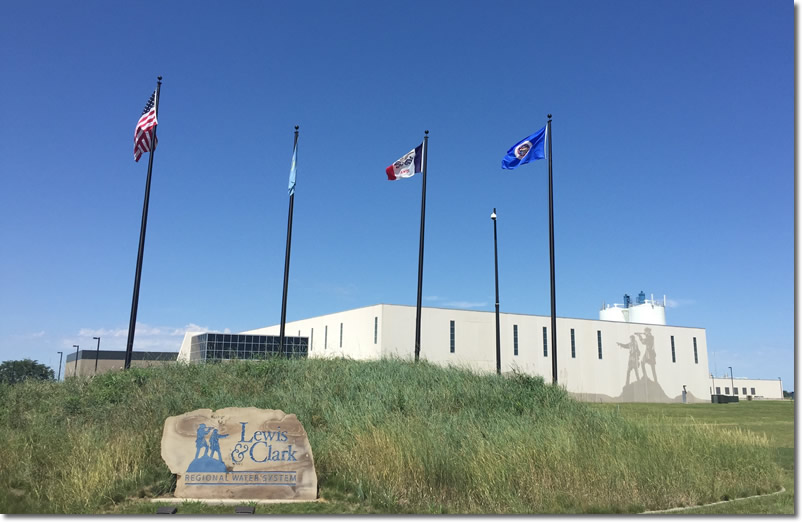
The photos below show work progressing on a pipeline between Luverne and Worthington as well as a 4-million gallon reservoir in Rock County, just south of Luverne.
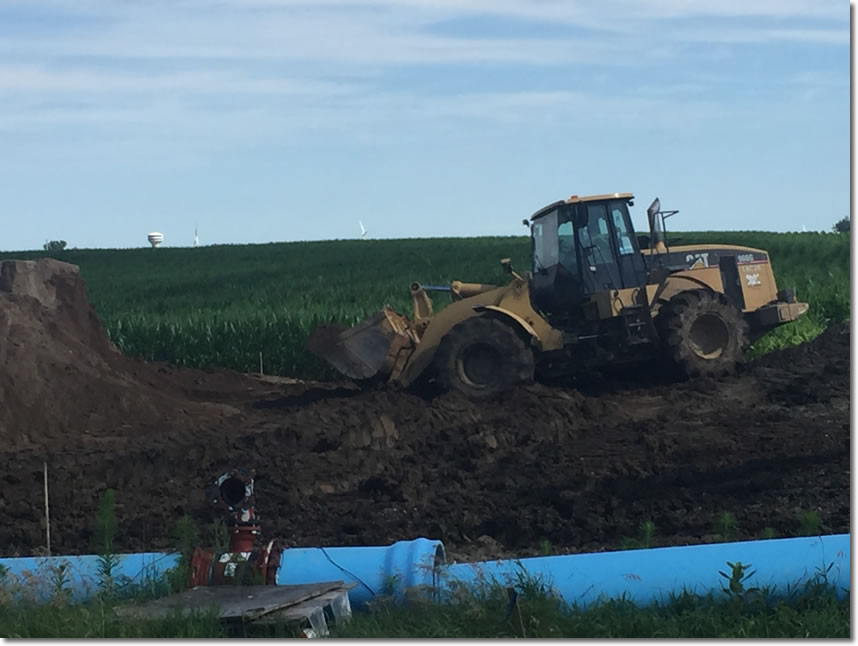
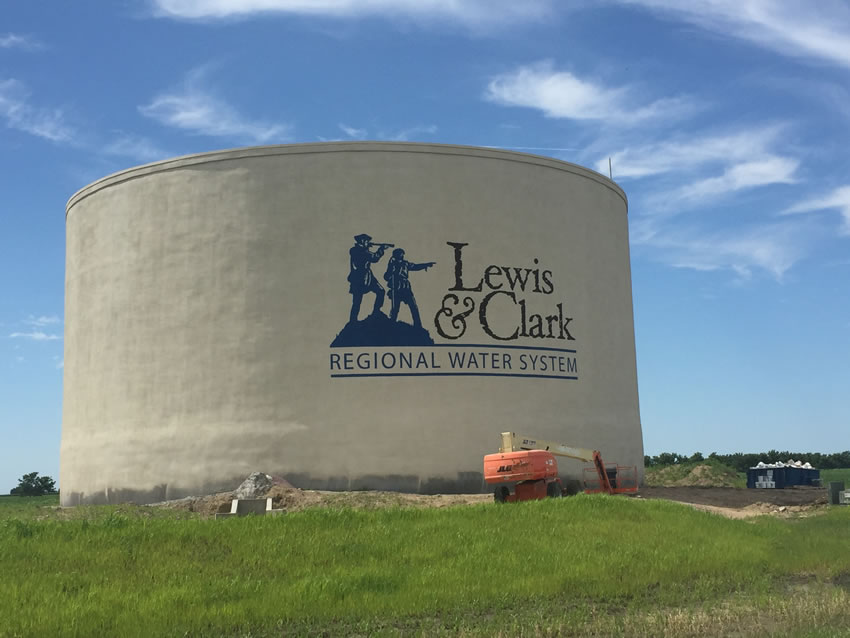
Go to top
Past Waterlines Archived at wateroperator.org
The Minnesota Department of Health is archiving past issues of the Waterline for only the previous three years. However, wateroperator.org is hosting past issues back to 1997.
To access these, go to Search for Documents. Select the following filter criteria: HOST – Minnesota Department of Health; TYPE – Newsletters/Magazines; STATE – Minnesota. Click the “Retrieve Documents” button.
Go to top
Sign Up for Groundwater Updates
Public water systems are encouraged to learn about when Minnesota Department of Health (MDH) chemical reviews are initiated and when health-base guidance for water is issued.
Use the link below to sign up for MDH Groundwater Email Updates and get notified about new and revised health-based guidance values for water.
Minnesota Department of Health Groundwater Email Updates
Go to top
Cool Videos
The Minnesota Department of Health has produced an instructional video for taking lead and copper samples.
The Minnesota Section of American Water Works Association (AWWA) has produced a promotional video on the benefits of AWWA membership.
Words of Wisdom of Being Involved
Go to top
Drinking Water Institute in Rochester
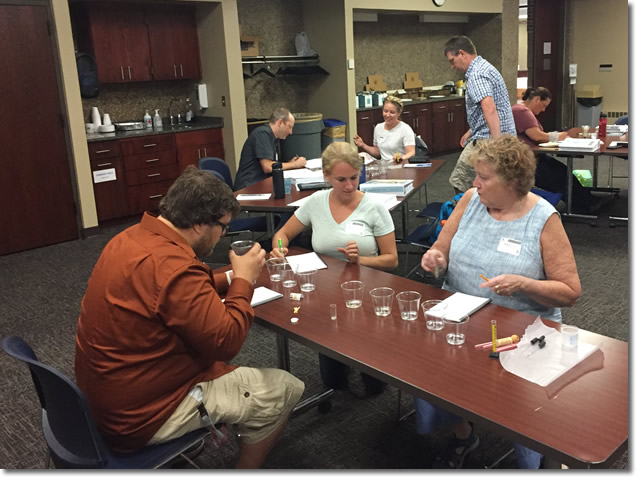
The annual Drinking Water Institute for Educators was held in August at Rochester Public Utilities. The Minnesota Department of Health and Minnesota Section of American Water Works Association have been conducting these institutes since 2001. Science teachers from around the state come together and develop action plans to create inquiry-based activities that they can integrate into their existing science curriculum. The 2019 Drinking Water Institute will be August 5-7 in Oakdale. More information: WaterWorks! A Drinking Water Institute for Educators
Go to top
Chaska Prevails in Great Minnesota Tap Water Taste Test
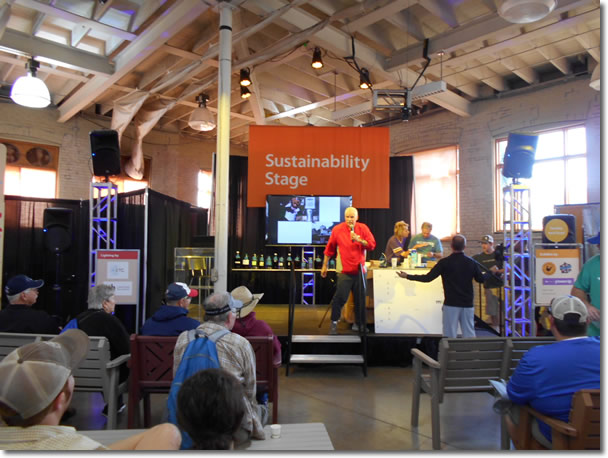
Minnesota American Water Works Association (AWWA) held its seventh annual Great Minnesota Tap Water Taste Test on the Sustainability Stage in the Eco Experience building at the Minnesota State Fair. With the audience serving as judges, Chaska was voted the best tasting water in Minnesota. Its water—along with the water of the other finalists, Eagan, Apple Valley, St. Louis Park, and St. Paul—was brought to the WCCO Radio booth.
As a Minnesota AWWA spokesperson talked about the contest and drinking water in Minnesota, members of the live WCCO audience tasted the samples and reaffirmed Chaska as the best tasting.
In the photo below, Bert Tracy tells WCCO listeners the results of the taste test as hosts Jordana Green (hidden by an unidentified photo bomber) and Paul Douglas applaud wildly. Jordana and Paul both picked Chaska and St. Louis Park as their favorites.
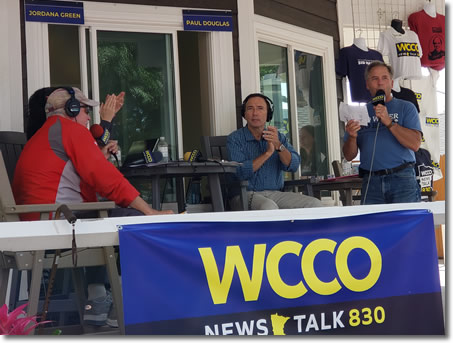
Go to top
Minnesota AWWA Conference
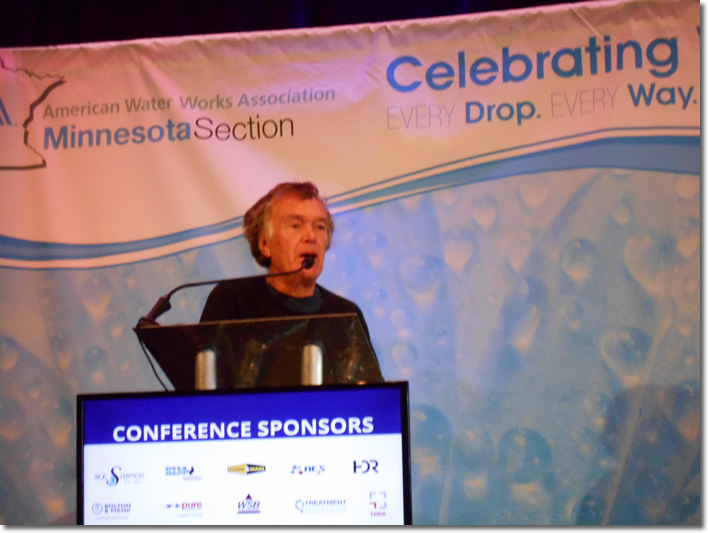
The 102nd annual Minnesota American Water Works Association conference, held in Duluth in September, featured keynote speaker Will Steger (above) and a variety of competitions, including pipe tapping (below).
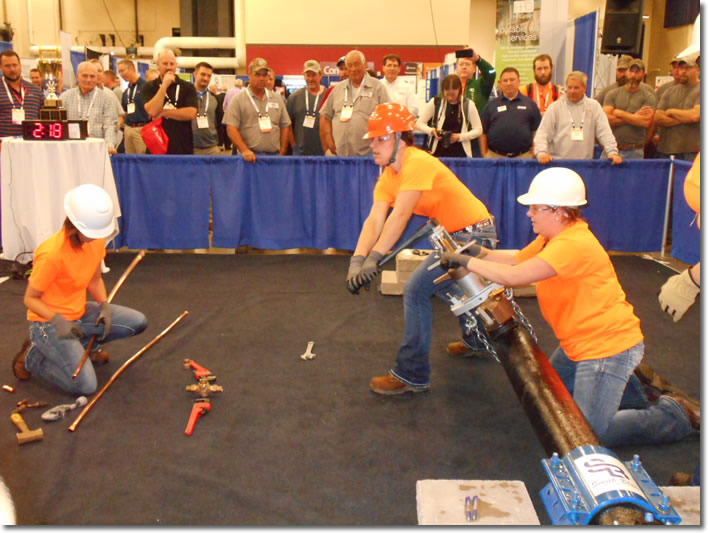
Go to top
Lewis & Clark Project: Nearing the Minnesota Finish Line
The tentacles of the Lewis & Clark Regional Water System (LCRWS) are nearly fully extended. Worthington will be the last stop in Minnesota, nearly 30 years after the city signed an agreement to be a partner in the project.
Lewis & Clark was conceived in 1988 with a simple idea: take water from a plentiful source and transport it to unplentiful places. The plentiful source is the Missouri River at Vermillion, South Dakota. The unplentiful sources range in different directions as far as 60 miles away.
Twenty members—in South Dakota, Iowa, and Minnesota—put up money to reserve certain amounts of water. The Minnesota partners are Rock County Rural Water District, Lincoln-Pipestone Rural Water System, and the cities of Luverne and Worthington.
The system was originally envisioned at 23.5 million gallons per day (MGD). However, after authorization in 2000, members requested additional water; as a result, the system and plant were designed for 45 MGD with the ability to expand to 60 MGD in the future.
Source and Treatment
Eleven wells draw from an aquifer that is recharged by the adjacent Missouri River at Vermillion. For South Dakota and beyond, the Missouri River is “the greatest natural water resource available,” according to LCRWS operations manager Jim Auen. “It is high-quality, abundant, and drought resistant.”
Through 54-inch pipes the water is pumped to a massive treatment plant north of Vermillion, which has been built in two phases, totaling approximately $90 million. Phase 1 (high service pump station, underground reservoir and electrical switchgear building) was $23.2 million, and Phase 2 (the main treatment plant) was $66.6 million.
The three-level plant has more than a quarter-million square feet, with room for expansion. The water is softened to reduce total hardness from approximately 300 parts per million (ppm) to 160 ppm. The lime in the softening process raises the pH, so a carbon dioxide feed system and recarbonation basins are used to adjust the pH before filtration.
The eight sand-and-anthracite filters, which have a Leopold underdrain system, remove iron and manganese. Sodium hypochlorite is added with ammonia for disinfection. Fluoride is also added. The treated water has total dissolved solids reduced to fewer than 500 mg/L.
Next to the plant is a 4.5 million gallon underground reservoir with a high service pump station and electrical switchgear building in addition to a nearby decant pond and three lime drying beds.
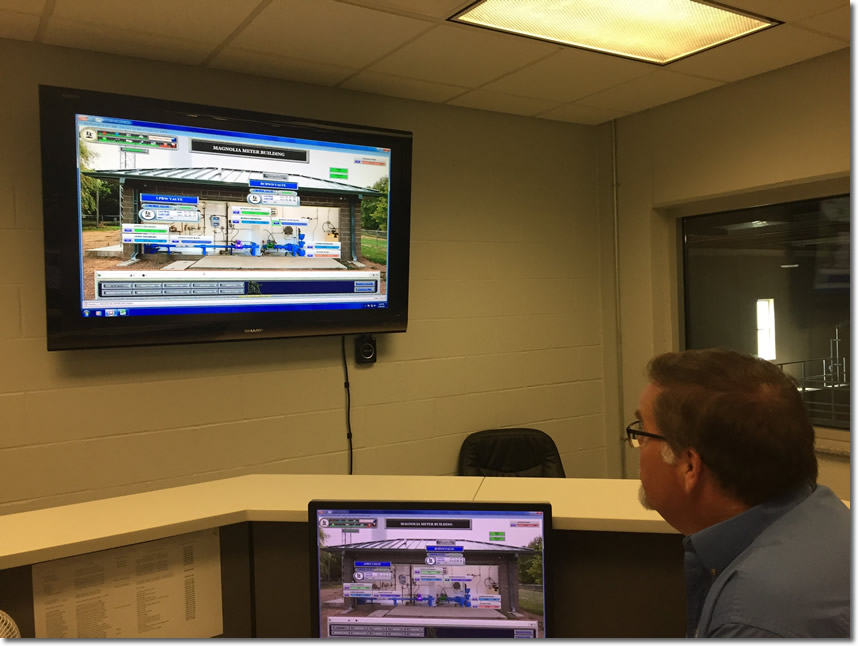
From the treatment plant in South Dakota, operations manager Jim Auen monitors the activity of a meter building in Magnolia, Minnesota.
Distribution
The water is sent 50 miles north to Tea, which is the hub of the entire system. Just south of Sioux Falls, Tea has a pair of 7.5 million reservoirs flanking a pump building. Some of the water from the plant has already branched off to communities in South Dakota and Iowa, although 90 percent of the water passes through Tea, including the water to Minnesota.
In July 2012 the system’s first water was pumped, to Sioux Falls and several smaller communities along the way, as well as to Rock Rapids, Iowa. The Minnesota members—being the farthest from the source—were the last to receive water. In May 2015 the project reached Minnesota, crossing the state line to deliver water to Rock County Rural Water District outside Luverne.
Since then it has gotten to Luverne and Lincoln-Pipestone Rural Water System, which serves an area that includes 38 cities in 10 counties. Along the way, connection points in Magnolia and Adrian have been hooked up. The water has allowed Luverne to be the site of Minnesota’s first shrimp hatchery and harbor, a commercial-scale shrimp producer. Construction on the $48 million facility, which will produce 150 million shrimp a year, will start in 2019.
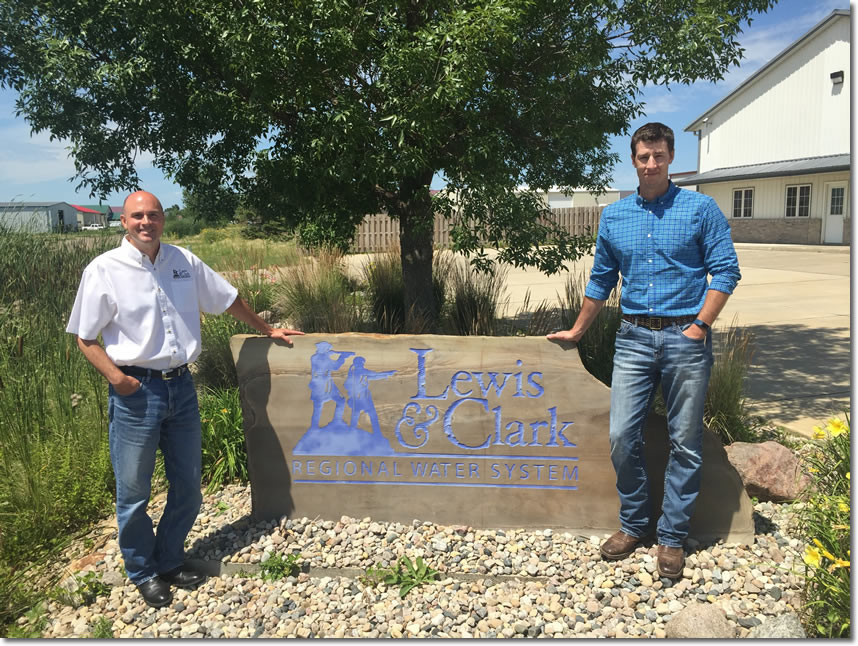
LCRWS executive director Troy Larson and construction administrator Clint Koehn (above) at the system headquarters in Tea, South Dakota, just a few miles from the Tea reservoirs and pump station (below).

Worthington
Though Worthington was the first Minnesota partner to sign up, it will be the last in the state to connect. By highway, it is 115 miles from Vermillion, the most remote city on the system. Worthington is directly on border of the Mississippi/Missouri River watershed. Its wellfield is surrounded and fed through groundwater/surface water interaction by man-made Lake Bella, seven miles to the south. With an average depth of fewer than 100 feet, the wells are susceptible to contamination and sensitive to drought.
Conservation is a way of life in Worthington, which has an aggressive leak detection program and high reclamation of backwash water. The city has also been creative in partnering with other organizations, including Pheasants Forever chapters, in source water protection, purchasing and setting aside land for conservation. “We have partners willing to do things that were unheard of in the past,” said Worthington water superintendent Eric Roos. (Learn more by watching Invisible Heroes: Worthington).
The ongoing need for water caused Worthington to become the first partner outside of South Dakota to reserve water. As the network of pipes extends west from Luverne to Worthington, LCRWS has constructed a meter building next to the Worthington water treatment plant while the city is building an adjacent high-service pump station. The pump station will receive water out of both the city’s ground storage and from the Lewis & Clark supply to send out through its distribution system. “We’re going to put out a consistent blend to our customers,” said Roos.
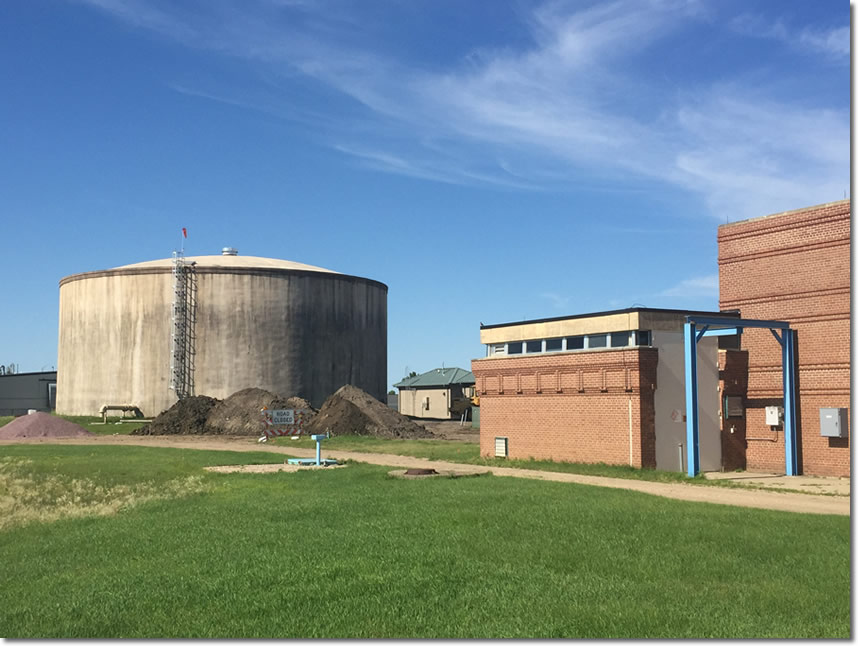
To the left of the Worthington Water Treatment Plant are a meter building and reservoir, part of the Lewis & Clark Regional Water System.
Reaching the Finish Line
As the Minnesota portion of the project wraps up with Worthington as the 15th overall partner to connect, five more systems still await their water—four in Iowa and one in South Dakota.
The financing is covered on an 80-10-10 system: 80 percent from the federal government, 10 percent by the states, and 10 percent by the individual members. To this point, the states and local entities have paid 100 percent of their costs. Approximately $188 million is still coming from the federal government. Troy Larson, executive director of Lewis & Clark, says the Congressional delegations from the three states have been supportive, and he noted the efforts of Minnesota Governor Mark Dayton, particularly with advances for eventual federal funding.
The total project cost is estimated at $605 million, with over half the capital cost for the construction of the distribution system, which will have more than 332 miles of pipes.
When the project is completed, more than 300,000 residents—not to mention significant industries—will be receiving Lewis & Clark water over 5,000 square miles, a service area the size of Connecticut.
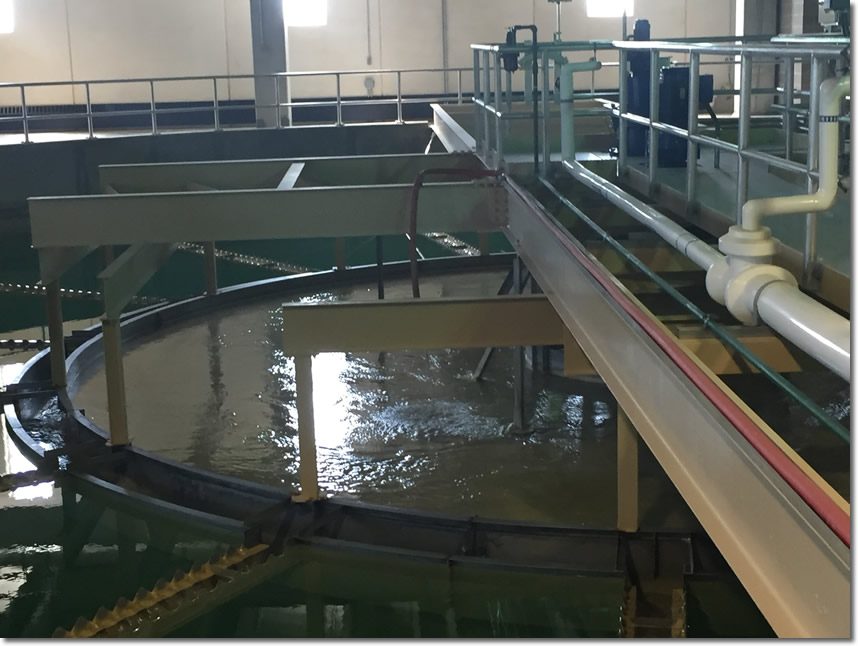
The softening basins (above) and filters (below) at the Vermillion plant. The pipes on the filters have been stubbed to allow for expansion with an addition to the building to the north.
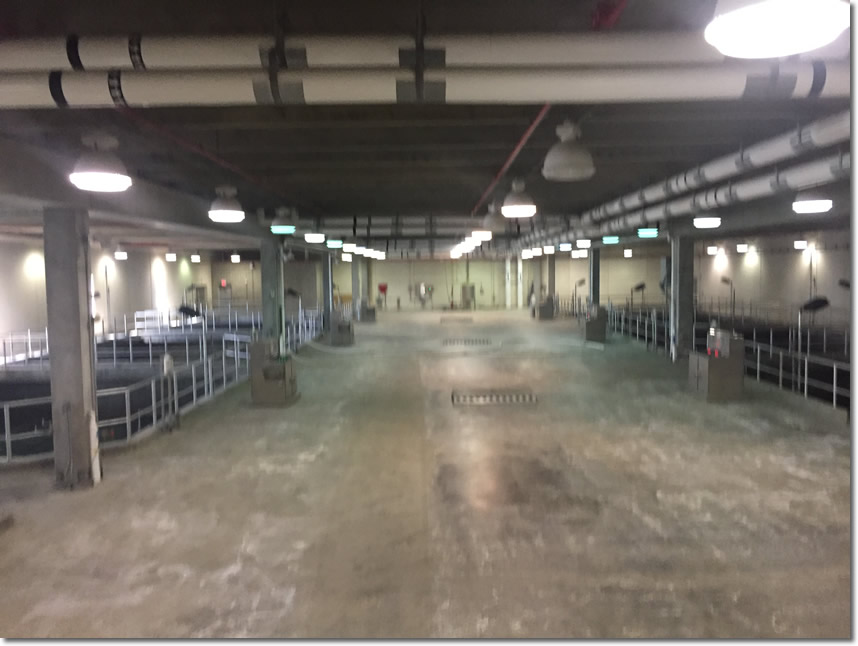
Related: Worthington Explores Lewis & Clark
Go to top
Fact Sheets, Resources Now on MDH Web Page
The Minnesota Department of Health drinking water web page has new fact sheets:
- Legionella Information (PDF)
- Home Water Treatment
- Beware of Water Treatment Scams
- Backflow Prevention at Beverage Dispensers to Prevent Copper Poisoning (PDF)
- Lead Poisoning Prevention: Lead in Schools
- Drinking Water in Schools, Child Care and Head Start Programs
- Reducing Lead in Drinking Water (PDF)
It also has new templates water systems can use to communicate with their customers about water quality changes:
Important Information about Your Drinking Water
Go to top
Historic St. Paul Ballpark Leads to Information on Early Water Supply in City
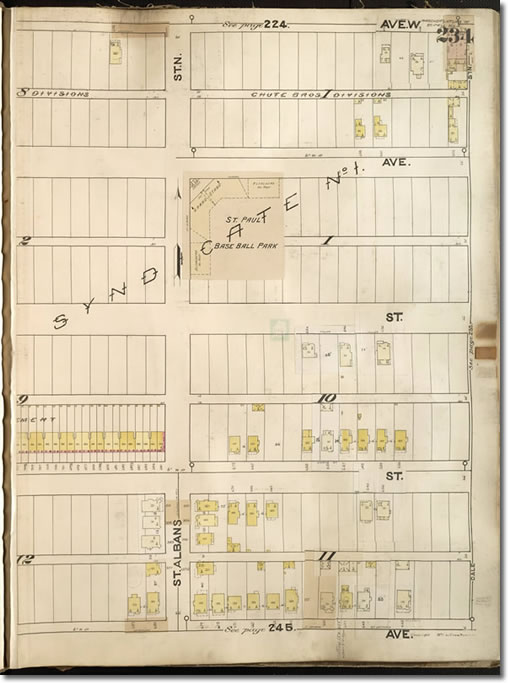
Researcher Cary Smith of the Baseball Hall of Fame came up with this map showing an 1890s baseball park in St. Paul.
Cary Smith, a Minnesota native who works at the Baseball Hall of Fame in Cooperstown, New York, discovered that an 1895 ballpark built in St. Paul had showers installed. “I am trying to figure out if by 1895 that was a common thing or a relatively new and high-tech thing,” he asked.
The ballpark was on the northwest corner of Aurora Avenue, one block south of University Avenue, and St. Albans Street, one block west of Dale Street. Fuller Avenue is to the south.
Known as the Dale and Aurora Grounds, the ballpark was built for a new St. Paul minor-league team—owned and managed by Charles Comiskey—that played in the Western League. A few years later the Western League changed its name to the American League and became a major league. However, after the 1899 season, Comiskey moved the St. Paul team to Chicago. The team still exists, as the Chicago White Sox, and Comiskey is a member of the Baseball Hall of Fame.
Ben Feldman, a project engineer for St. Paul Regional Water Services, looked into the water history of the area and got drawn into a mystery that required gumshoe work worthy of Hercule Poirot, Sherlock Holmes, or even Jim Rockford.

Ben Feldman of St. Paul Regional Water Services found this 1895 water permit for the ballpark, signed by John Comiskey, the dad of Charles, who supervised some of the construction.
Feldman found that a water main was installed for Aurora Avenue in 1889 and first thought that the city would have brought the service from near the intersection of St. Albans and Aurora to the grandstand of the ballpark.
However, he could find no record of old services in that location. “There are some abandoned services to the east of the intersection that had potential, but the one closest to the ballpark wasn’t installed until 1921. 1899 is the oldest date of those services, but they don’t quite coincide with the stadium construction date. The 1899 dates are not known for sure, but they all indicated having served the north side of Aurora. Again, not likely the stadium service. There doesn’t appear to ever have been a main installed in St. Albans and remains that way today.”
Feldman referred to a 2004 on-line article (Twin Cities Ballparks) that included a photo of the ballpark being used for curling. “The entire field was flooded, which means they had to be getting water from somewhere. Either they were getting it from a hydrant, a service, or a well. Given there was main in the street at the time, it wouldn’t make sense to have drilled a well. There are only two hydrants nearby—one at the intersection of St. Albans and Aurora and one at St. Albans and Fuller. It didn’t make sense to be dragging a hose across the street on Aurora, so it got me wondering if they were using the Fuller hydrant or possibly had a service off of Fuller.”

The photo above (courtesy of the Minnesota Historical Society), of a flooded Dale and Aurora Grounds, led Ben Feldman to the answer of where the water came from.
Below: The water service that supplied the 1890s ballpark is still being used for a duplex on the corner of Fuller and St. Albans.
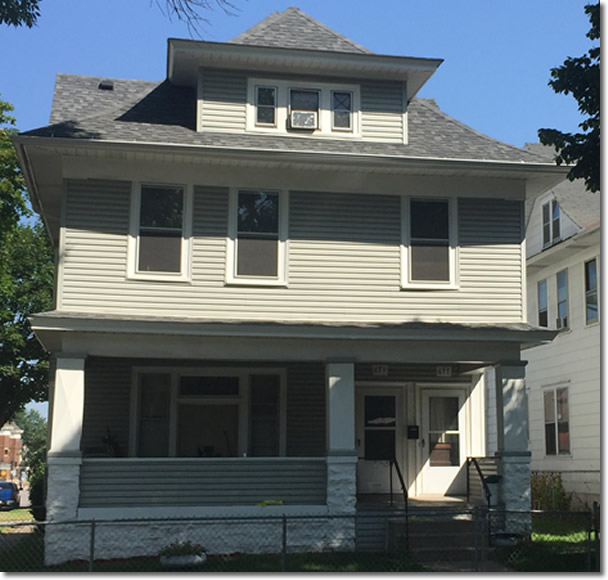
Feldman found that the main on Fuller was installed in 1891. “There are only two services on Fuller installed prior to 1900. One in 1891 to a house mid-block on the south side and one in 1895 right next to the hydrant at St. Albans and Fuller.”
On top of it all, this service is still being used today by a corner duplex now on the site. “It looks like we have quite a few services in the old neighborhoods that date back to the 1880s. Whether or not you had running water in your home at the time probably had more to do with your financial ability and if the city had the infrastructure in place,” Feldman concluded.
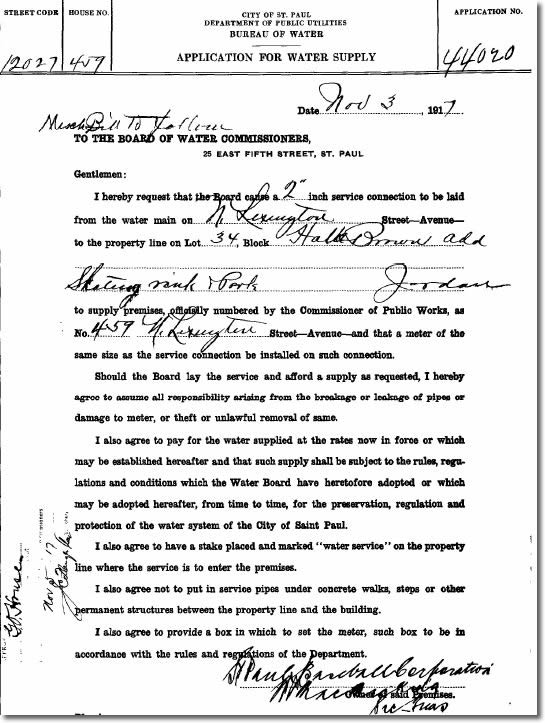
Once started on the history of water supply and St. Paul ballparks, Ben Feldman kept digging and found the original permit for water at Lexington Park, used by the St. Paul Saints from 1897 to 1956. The water installation date was December 10, 1917.
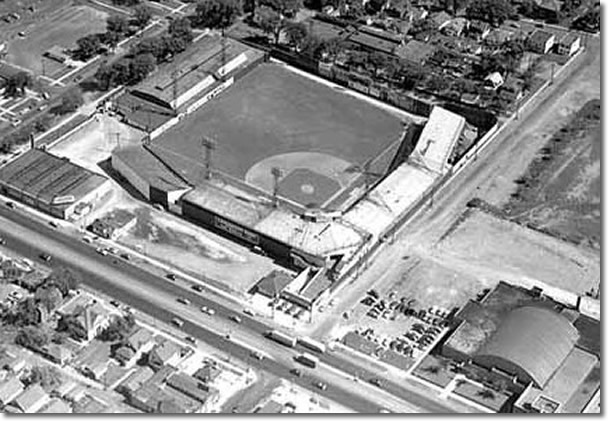
This 1952 photo of Lexington Park, looking to the southeast, shows University Avenue near the bottom (parallel to the third-base line) and Lexington Parkway beyond the left-field fence. A White Castle now stands at the corner of University and Lexington. Feldman says the location of the service was approximately at what is now the south edge of the White Castle driveway off of Lexington Parkway. Photo courtesy of the Minnesota Historical Society.
Go to top
New Display at State Fair Eco Experience
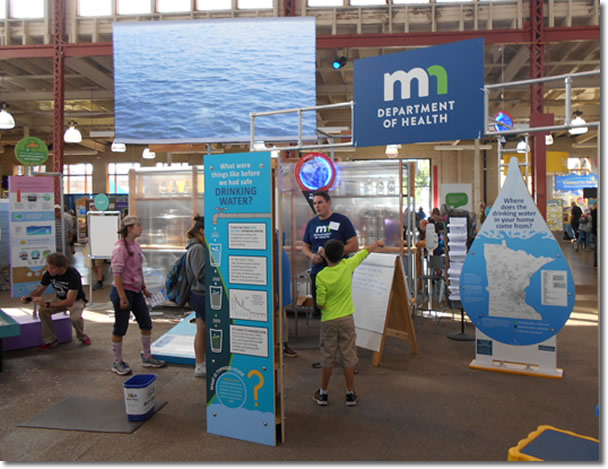 |
The Minnesota Department of Health partnered with Dunwoody College of Technology in Minneapolis for a new Eco Experience display at the State Fair. It included multi-sided pillars with information, including a map marking all community water systems (sorted by groundwater and surface water) in the state as well as private wells. There is also an interactive display on which fair visitors can use a magnet on a string to follow water through the ground. This was the beginning of a five-year partnership with Dunwoody students coming up with additional displays in the future. |
Go to top
MDH Funds Filling Stations
The Minnesota Department of Health has awarded grants to the following communities and organizations to install drinking fountains with bottle filling stations:
• Hmong American Partnership, St. Paul
• Arrowhead Economic Opportunity Agency, Virginia
• Mountain Lake Public School District ISD 173
• Partners in Quality Care, St. Paul
• Winona Public Library
• Perham Health
• Luverne Housing and Redevelopment Authority
• Brainerd Public Library
• White Bear Lake Area High School
• Parkview Center School, Roseville
• Benson School
• International Falls ISD 361
• Blue Earth School
• New London-Spicer School, New London
• Holy Cross Catholic School, Webster
• Goodridge ISD 561
The fountains provide an alternative to bottled water, protect people from exposure to lead in older water fountains, retain fluoride from the water supply, and promote healthy behaviors by providing an alternative to sugary beverages. Sugary beverages, according to the Centers for Disease Control, are linked to Type 2 diabetes, obesity, tooth decay, heart disease, and other chronic diseases.
Go to top
Southeast School Changing Locations
After more than 30 years at the Kahler Apache Hotel in Rochester, the Southeast District Minnesota AWWA will have a new location for its water operator school in 2019. The hotel has closed, so the three-day school—from Wednesday, March 13 to Friday, March 15—will be at the Rochester Event Center next to the airport on the south end of Rochester. An AmericInn across the street is available for hotel rooms.
Go to top
Words to Live By
Blessed are they who have nothing to say and who cannot be persuaded to say it.
—James Russell Lowell
Go to top
Reminder to All Water Operators
When submitting water samples for analyses, remember to do the following:
- Take coliform samples on the distribution system, not at the wells or entry points.
- Write the Date Collected, Time Collected, and Collector’s Name on the lab form.
- Attach the label to each bottle (do not attach labels to the lab form).
- Include laboratory request forms with submitted samples.
- Do not use a rollerball or gel pen (the ink may run).
- Consult your monitoring plan(s) prior to collecting required compliance samples.
Notify your Minnesota Department of Health district engineer of any changes to your systems.
If you have questions, call the Minnesota Department of Health contact on the back of all sample instruction forms.
Calendar
Operator training sponsored by the Minnesota Department of Health and the Minnesota AWWA will be held in several locations this spring.
Register for schools and pay on-line:
Go to top